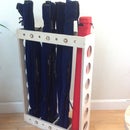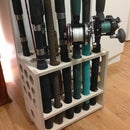Introduction: Fishing Reel Rebuild and Customization With 3D Printed Parts
Here's my rebuild of a classic 700 series Penn Spinning reel. Although these models first appeared about 40 years ago, the simple construction and durability have kept them popular with fisherman. I fabricated new plastic parts, upgraded the drag and finished off with a nice powder coated finish.
The "before" photo is from a nearly identical reel (with permission from Alto Mare at alantani.com). I forgot to take my own!
Step 1: Troubleshoot and Dissamble
First step is to find out what is not working on the reel. For this reel the rotor cup was wobbly, the drag a bit sticky, and the eccentric (anti-reverse) lever was floppy, and the plastic handle was getting a bit sloppy on the shaft.
Now take the reel apart entirely, clean and examine each component for wear. Also check to see if any parts are missing. There are good reel rebuild tutorials for many reels (including this one) and plenty of good advice at alantani.com. Schematics for Penn reels can be found at pennparts.com.
The wear looked minimal for the major components. However the plastic drag cap was broken from stress at the thrust insert. A perusal of the schematic showed that this reel was missing a part- (shaft spacer/bushing)- so this was causing the rotor cup wobble.
With older reels it is useful to make a replacement parts list and ensure parts are available. For this reel, all of the parts I needed were available except the drag cap. A quick perusal of online auction sites showed that used drag caps were available, but most were cracked where mine was broken.
I wanted to repaint the reel as well, so quick trip to the sandblaster was in order to ensure that the paint could easily be removed. I did a test on the inside of the side plate- it came right off- you can see in the photo below. The black plastic parts are the new ones that I fabricated- see step 2.
As a note- many spinning reels are horribly complicated and and not too durable, making them difficult and expensive to repair. Not counting screws and washers, this reel is probably under 50 parts, making it a good candidate for a successful overhaul.
Step 2: Fabricating Plastic Parts
I decided to design new and improved versions of the handle and knob that kept the original design cues but were more durable and functional.
The handle is slightly larger than the original, and also rounded the edges. There are pockets for delrin or nylon bushings.
The drag knob is slightly taller than the original , making it easier to adjust the drag- it still has to clear an open bail. The design allowed me to salvage the metal thrust insert and nut from the original cap. I made the plastic ring around the thrust insert thicker than the original as this appeared to be a common weak point.
Drew the new parts up in Autodesk Inventor and then off to the 3D printer. I used ABS plastic for strength. I could order fancier /tougher resin printed versions of these parts, but for a smaller reel such as this, I expect that that the consumer grade extrusion printed ABS parts will be fine.
Step 3: Powder Coat
In order to powder coat a cast aluminum reel it had to be sand blasted clean (protect the threaded holes with some screws), and then pre-baked in the powder coat oven to "out-gas" all of the grease it had absorbed through the years. I was surprised at the amount of grease that came out. The part is then washed (simple green). I had to repeat this process to get the crud out of the part. I made silicone plugs for the threaded holes with some RTV rubber I had lying around (make sure it is approved for the heat required to bake your paint). Then a coat of light chrome finish and then an almost matte blackish "clear" coat.
It was quite a pain to protect all of the threads and pressed bushings through the blasting and painting.
Final result was pretty good. Paint was quite hard and even, but a few fisheyes, probably because I did not out-gas enough. The blasting process took all the scratches of the part.
Step 4: Assemble and Test Drive.
I assembled the reel using the schematics and tips from the tutorial at alantani.com. All of the moving parts are greased. It is also a good idea to lightly coat all internal surfaces with grease, especially if the reel is used in salt water. The only hot-rodding done to this reel was an upgrade from nylon to carbon fiber drag material. It is a very good idea to lightly coat the drag washers with a special grease made specifically for Carbon Fiber drags (I use Cals).
After assembly, everything worked-as new or better. The bail needed a little bending to allow it to fully close during use.
Ready for another 40 years!













